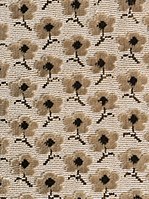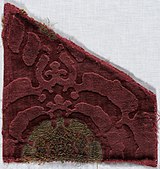Velvet
This article needs additional citations for verification. (August 2021) |

Velvet is a type of woven tufted fabric in which the cut threads are evenly distributed, with a short dense pile, giving it a distinctive soft feel. By extension, the word velvety means "smooth like velvet". Velvet can be made from either natural or synthetic fibers.
Construction and composition[]
This section relies largely or entirely upon a single source. (August 2021) |

Velvet is woven on a special loom that weaves two thicknesses of the material at the same time. The two pieces are then cut apart to create the pile effect, and the two lengths of fabric are wound on separate take-up rolls. This complicated process meant that velvet was expensive to make before industrial power looms became available, and well-made velvet remains a fairly costly fabric. Velvet is difficult to clean because of its pile, but modern dry cleaning methods make cleaning more feasible. Velvet pile is created by warp or vertical yarns and velveteen pile is created by weft or fill yarns.
Velvet can be made from several different kinds of fibers, traditionally, the most expensive of which is silk. Much of the velvet sold today as "silk velvet" is actually a mix of rayon and silk.[1] Velvet made entirely from silk is rare and usually has market prices of several hundred US dollars per yard. Cotton is also used to make velvet, though this often results in a less luxurious fabric. Velvet can also be made from fibers such as linen, mohair, and wool. A cloth made by the Kuba people of the Democratic Republic of Congo from the raffia palm is often referred to as "Kuba velvet". More recently, synthetic velvets have been developed, mostly from polyester, nylon, viscose, acetate, and from either mixtures of different synthetics or from combined synthetics and natural fibers (for example viscose mixed with silk produces a very soft, reflective fabric). A small percentage of spandex is sometimes added to give the final material a certain amount of stretch (hence "stretch velvet").
History[]

Because of its unusual softness and appearance as well as its high cost of production, velvet has often been associated with nobility. Velvet was introduced to Baghdad during the rule of Harun al-Rashid (786–809) by Kashmiri merchants and to Al-Andalus by Ziryab. In the Mamluk era, Cairo was the world's largest producer of velvet. Much of it was exported to Venice (whence it spread to most of Europe), Iberia and the Mali Empire. Mansa Musa, the ruler of the Mali Empire, visited Cairo on his pilgrimage to Mecca. Many Arab velvet makers accompanied him back to Timbuktu. Later Ibn Battuta mentions how Suleyman, the ruler of Mali, wore a locally produced complete crimson velvet kaftan on Eid. During the reign of Mehmed II, assistant cooks wore blue dresses (câme-i kebûd), conical hats (کلاه, külâh) and baggy trousers (چاقشیر, çakşır) made from Bursa velvet.[citation needed]
King Richard II of England directed in his will that his body should be clothed in velveto in 1399.[2]

The Encyclopædia Britannica Eleventh Edition described velvet and its history thus:
VELVET, a silken textile fabric having a short dense piled surface. In all probability the art of velvet-weaving originated in the Far East; and it is not till about the beginning of the 14th century that we find any mention of the textile. The peculiar properties of velvet, the splendid yet softened depth of dye-colour it exhibited, at once marked it out as a fit material for ecclesiastical vestments, royal and state robes, and sumptuous hangings; and the most magnificent textures of medieval times were Italian velvets. These were in many ways most effectively treated for ornamentation, such as by varying the colour of the pile, by producing pile of different lengths (pile upon pile, or double pile), and by brocading with plain silk, with uncut pile or with a ground of gold tissue, &c. The earliest sources of European artistic velvets were Catanzaro,[3][4] Lucca, Genoa, Florence, and Venice, which continued to send out rich velvet textures. Somewhat later the art was taken up by Flemish weavers, and in the sixteenth century, Bruges attained a reputation for velvets that were not inferior to those of the great Italian cities.[5]
Types[]
- Chiffon (or transparent) velvet: very lightweight velvet on a sheer silk or rayon chiffon base.[6]
- Ciselé: velvet where the pile uses cut and uncut loops to create a pattern.[6]
- Crushed: lustrous velvet with patterned appearance that is produced by either pressing the fabric down in different directions, or alternatively by mechanically twisting the fabric while wet.[7]
- Devoré or burnout: a velvet treated with a caustic solution to dissolve areas of the pile, creating a velvet pattern upon a sheer or lightweight base fabric.[7]
- Embossed: velvet on which a metal roller has been used to heat-stamp the fabric, producing a pattern.[7]
- Hammered: an extremely lustrous velvet with a crushed and dappled appearance.[7]
- Lyons: a densely woven, stiff, heavier-weight pile velvet used for hats, coat collars and garments.[6][8]
- Mirror: a type of exceptionally soft and light crushed velvet.[8]
- Nacré: velvet with an effect similar to shot silk where the pile is woven in one or more colours and the base fabric in another, creating a changeable, iridescent effect.[6][8]
- Panne: a type of crushed velvet produced by forcing the pile in a single direction by applying heavy pressure.[9] Sometimes, less frequently, called paon velvet.[10] However, since the 1970s, "panne velvet" as used in ordinary fabric stores has referred to a pile knit, perhaps better called a velour, with a short pile that falls in many directions; usually of polyester.
- Pile-on-pile, also called double velvet: a particularly luxurious type of velvet woven with piles of differing heights to create a pattern. It is one of the oldest known velvet weaving techniques.[11][12][13]
- Plain: velvet commonly made of cotton with a firm hand.[7]
- Ponson: A very heavy and quite expensive velvet made either entirely with silk or having a pile exclusively of silk, used at one point for women's dresses and cloaks
- Utrecht: a pressed and crimped velvet associated with Utrecht, the Netherlands.[6]
- Velveteen: a type of imitation velvet.[9] It is normally made of cotton or a combination of cotton and silk. It has a pile that is short (never more than 3mm deep), and is closely set. It has a firm hand and a slightly sloping pile. Unlike true velvet, this type has greater body, does not drape as easily, and has less sheen.[7]
- Voided: velvet deliberately woven with areas of pile-free ground (usually satin) forming a pattern.[14]
- Wedding ring or ring velvet: another term for devoré and/or chiffon velvets which are allegedly fine enough to be drawn through a wedding ring.[15]
Gallery[]

Ciselé

Devoré

Embossed

Pile-on-pile

Voided
Fibers[]
This section relies largely or entirely upon a single source. (August 2021) |
- Cotton – Cotton velvet is highly durable but lacks much of the luxuriousness of other varieties of velvet; also, its colors tend not to be as deep or rich
- Silk – Silk velvet is more expensive than plain velvet, and is usually shinier and softer than the cotton variety[7]
- Microfiber – Microfiber velvet is a polyester variety of the fabric that resists stains easily and is lightweight
- Nylon/rayon blend – Nylon/rayon blend velvet has much of the feel and drape of silk-based velvet, but is usually much less expensive; also, it is easier to care for than silk velvet
- Polyester/spandex – Polyester/spandex velvet (often called "stretch velvet") can be made of polyester with a small percentage of spandex to allow it to stretch in one or two directions
- Viscose – In terms of quality, viscose velvet is more similar to silk velvet than cotton velvet[7]
See also[]
- Corduroy, striped ridged form of velvet fabric
- Flocking (texture), a velvety texture produced by bonding short fibers to fabric, paper, or any surface
- Velour, or velours, a plush, knitted fabric or textile
- Velvet painting
- Terrycloth, a woven fabric with an uncut pile created by warp or weft.
References[]
| Wikimedia Commons has media related to Velvet. |
- ^ Jeanne Stauffer (1 January 2004). Sewing Smart with Fabric. DRG Wholesale. p. 73. ISBN 978-1-59217-018-0.
- ^ L W Cowrie. Dictionary of British Social History. Wordsworth Reference. p. 304. ISBN 1-85326-378-8.
- ^ https://treccani.it/enciclopedia/velluto_(Enciclopedia-Italiana)/
- ^ https://lopificio.it/en/blog/discover-the-velvet-hair-fabric
- ^ One or more of the preceding sentences incorporates text from a publication now in the public domain: Chisholm, Hugh, ed. (1911). "Velvet". Encyclopædia Britannica. 27 (11th ed.). Cambridge University Press. pp. 979–980.
- ^ Jump up to: a b c d e Maitra, K.K. (2007). Encyclopaedic dictionary of clothing and textiles. New Delhi: Mittal Publications. p. 479. ISBN 9788183242059.
- ^ Jump up to: a b c d e f g h "Free patterns - Velvet". sewingtechnology.net. Archived from the original on 2011-02-23.CS1 maint: unfit URL (link)
- ^ Jump up to: a b c Schaeffer, Claire (2003). Sew Any Fabric: A Quick Reference to Fabrics from A to Z. Krause Publications. p. 129. ISBN 9781440220333.
- ^ Jump up to: a b "Fabric Properties and Distinctions - Velvet". fabrics.net. Archived from the original on 2010-12-17.CS1 maint: unfit URL (link)
- ^ Denny, Grace Goldena (1947). Fabrics. J. B. Lippincott Company. p. 77.
Panne or paon velvet. Finish on lightweight velvet. Pile laid flat in one direction.
- ^ Rosalie Gilbert. "Rosalie's Medieval Woman".
- ^ Phipps, Elena (2012). Looking at textiles: a guide to technical terms. Los Angeles, Calif.: J. Paul Getty Museum. p. 81. ISBN 9781606060803.
- ^ Crowfoot, Elisabeth; Pritchard, Frances; Unwin, Kay Staniland; photography by Edwin Baker; illustrations by Christina (2006). Textiles and clothing, c.1150-c.1450 (New ed.). Woodbridge, Suffolk, UK: Boydell. p. 127. ISBN 9781843832393.
- ^ Landl, Sheila (2012). Textile Conservator's Manual (2, revised ed.). Routledge. p. 199. ISBN 9781135145200.
- ^ Strong Hillhouse, Marian (1963). Dress selection and design. Macmillan. p. 156.
Chiffon velvet is also called "wedding ring velvet," because it is supposedly so light _and soft it can be pulled through a wedding ring.
- Pile fabrics








